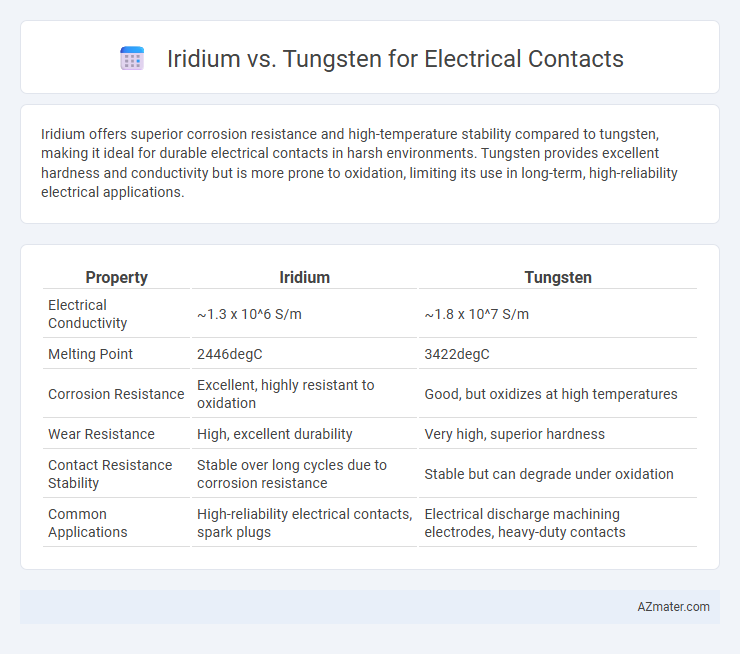Iridium offers superior corrosion resistance and high-temperature stability compared to tungsten, making it ideal for durable electrical contacts in harsh environments. Tungsten provides excellent hardness and conductivity but is more prone to oxidation, limiting its use in long-term, high-reliability electrical applications.
Table of Comparison
| Property | Iridium | Tungsten |
|---|---|---|
| Electrical Conductivity | ~1.3 x 10^6 S/m | ~1.8 x 10^7 S/m |
| Melting Point | 2446degC | 3422degC |
| Corrosion Resistance | Excellent, highly resistant to oxidation | Good, but oxidizes at high temperatures |
| Wear Resistance | High, excellent durability | Very high, superior hardness |
| Contact Resistance Stability | Stable over long cycles due to corrosion resistance | Stable but can degrade under oxidation |
| Common Applications | High-reliability electrical contacts, spark plugs | Electrical discharge machining electrodes, heavy-duty contacts |
Introduction to Iridium and Tungsten
Iridium and tungsten are both transition metals commonly used in electrical contacts due to their excellent conductivity and durability. Iridium is known for its exceptional corrosion resistance and high melting point of 2446degC, making it ideal for harsh environments. Tungsten offers superior hardness and a melting point of 3422degC, providing stability and performance in high-temperature applications.
Key Properties of Iridium and Tungsten
Iridium offers exceptional corrosion resistance, high melting point of 2446degC, and excellent electrical conductivity, making it ideal for durable electrical contacts in harsh environments. Tungsten features the highest melting point among metals at 3422degC, outstanding hardness, and good electrical conductivity, suitable for high-temperature and high-wear applications. Both metals provide reliable electrical performance, but iridium excels in chemical stability while tungsten is preferred for extreme temperature resistance.
Electrical Conductivity Comparison
Iridium exhibits lower electrical conductivity than tungsten, with iridium's conductivity at approximately 1.3 x 10^6 S/m compared to tungsten's higher value near 1.8 x 10^7 S/m. Tungsten's superior electrical conductivity makes it more efficient for electrical contact applications, where minimizing resistance and heat generation is critical. Despite iridium's excellent corrosion resistance, tungsten's balance of conductivity and mechanical strength remains preferable for high-performance electrical contacts.
Mechanical Strength and Durability
Iridium exhibits superior mechanical strength and exceptional resistance to deformation, making it highly durable for electrical contacts exposed to high stress and vibration. Tungsten offers excellent hardness and high melting point, contributing to wear resistance, but its brittleness can lead to microfractures under mechanical stress. The combination of iridium's toughness and tungsten's hardness often results in improved longevity and reliability in demanding electrical contact applications.
Corrosion and Oxidation Resistance
Iridium exhibits superior corrosion and oxidation resistance compared to tungsten, making it highly reliable for electrical contacts in harsh environments. While tungsten is prone to oxidation at elevated temperatures, leading to reduced conductivity and contact failure, iridium maintains stability and conductivity due to its noble metal properties. This inherent resistance to atmospheric degradation ensures longer contact lifespan and consistent electrical performance in critical applications.
Performance in High-Temperature Environments
Iridium exhibits exceptional corrosion resistance and electrical conductivity, making it ideal for high-temperature electrical contacts operating above 1000degC. Tungsten offers superior mechanical strength and thermal stability but tends to oxidize at elevated temperatures, limiting its performance in harsh oxidative environments. Iridium's stable oxide layer ensures consistent electrical performance and longevity in extreme heat, outperforming tungsten in critical high-temperature applications.
Cost and Availability
Iridium offers exceptional corrosion resistance and electrical conductivity for electrical contacts but comes with a significantly higher cost due to its rarity and complex extraction process. Tungsten is more abundant and cost-effective, providing excellent durability and thermal conductivity, though it is less corrosion-resistant than iridium. The choice between iridium and tungsten for electrical contacts often depends on budget constraints and the specific environmental conditions of the application.
Applications in Electrical Contacts
Iridium exhibits exceptional corrosion resistance and high melting point, making it ideal for electrical contacts in harsh environments such as aerospace and chemical processing equipment. Tungsten offers superior hardness and excellent conductivity, commonly used in switching devices and electrical contacts requiring high wear resistance. Both metals enable reliable conductivity under extreme conditions, but iridium's resistance to oxidation makes it preferable in high-temperature, oxidative atmospheres.
Environmental and Safety Considerations
Iridium exhibits superior corrosion resistance and chemical stability, making it more environmentally friendly for electrical contacts due to reduced risk of hazardous degradation products. Tungsten, while cost-effective and durable, poses environmental concerns related to dust inhalation and potential toxicity during manufacturing and disposal. Selecting iridium minimizes ecological impact and enhances worker safety by limiting exposure to harmful substances and extending contact life in harsh environments.
Choosing the Right Material for Electrical Contacts
Iridium offers exceptional corrosion resistance and high melting point, making it ideal for electrical contacts exposed to harsh environments and high temperatures. Tungsten provides superior electrical conductivity and mechanical strength but is more prone to oxidation, requiring protective coatings in demanding applications. Choosing the right material depends on specific operational conditions such as current load, temperature, and environmental exposure to ensure reliability and longevity of electrical contacts.

Infographic: Iridium vs Tungsten for Electrical Contact
 azmater.com
azmater.com